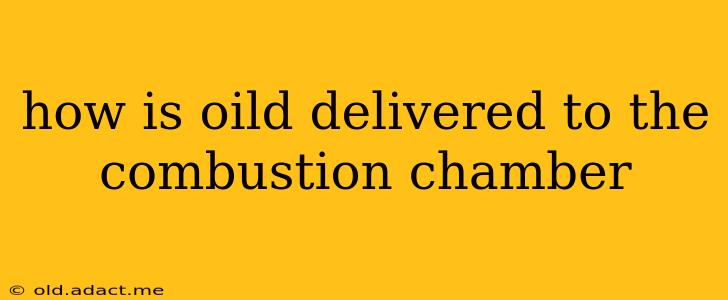The delivery of oil to a combustion chamber depends heavily on the type of engine or system in question. This process, crucial for efficient and controlled burning, differs significantly between internal combustion engines (like those in cars and trucks), industrial burners, and even domestic heating systems. Let's explore the key methods.
Internal Combustion Engines (ICE): Gasoline and Diesel
In gasoline and diesel internal combustion engines, the delivery system is complex and precise, aiming for optimal fuel-air mixture for combustion.
Gasoline Engines:
- Fuel Tank: The journey begins in the fuel tank, where gasoline is stored.
- Fuel Pump: A fuel pump, typically an electric pump, draws gasoline from the tank and pressurizes it. This pressure ensures consistent fuel delivery.
- Fuel Filter: A fuel filter removes any contaminants from the gasoline before it reaches the engine.
- Fuel Injectors (or Carburetor): In modern gasoline engines, fuel injectors precisely atomize and spray fuel directly into the combustion chamber at the optimal time, controlled by the engine's electronic control unit (ECU). Older engines use carburetors, which mix fuel and air mechanically before entering the combustion chamber. Injectors offer better control and efficiency.
- Combustion Chamber: The atomized fuel, mixed with air, ignites via a spark plug in gasoline engines.
Diesel Engines:
Diesel engines operate differently, relying on compression ignition rather than a spark.
- Fuel Tank: Similar to gasoline engines, diesel fuel is stored in a tank.
- Fuel Pump: A high-pressure fuel pump is crucial in diesel engines, delivering fuel at significantly higher pressures than gasoline systems.
- Fuel Injectors: Fuel injectors in diesel engines operate under extremely high pressure, injecting fuel directly into the combustion chamber. The intense pressure and heat generated by compression ignite the fuel.
- Combustion Chamber: The highly compressed air in the cylinder ignites the injected diesel fuel.
Industrial Burners and Heating Systems: Oil Delivery Methods
Industrial burners and home heating systems employing oil use different methods depending on the oil type and system design.
Oil Burners:
- Oil Tank: Oil is stored in a tank, usually underground for larger systems.
- Oil Pump: A pump draws oil from the tank and delivers it to the burner.
- Nozzle: The oil is atomized through a nozzle, creating a fine spray for efficient combustion.
- Air Supply: Air is mixed with the atomized oil, creating a combustible mixture.
- Ignition: An igniter starts the combustion process.
- Combustion Chamber: The atomized oil and air mixture burns within a combustion chamber, generating heat.
Different burner types exist (e.g., pressure atomizing, rotary cup, air atomizing) each with slightly different oil delivery mechanisms, but the basic principle remains the same.
What about other systems?
The principles are similar across many oil-burning systems, even those far removed from automobile engines. The key elements are consistent: storage, pumping, atomization (or precise metering for efficient combustion), and controlled introduction into the combustion chamber.
Frequently Asked Questions (FAQ)
What happens if the fuel delivery system fails?
A failure in the fuel delivery system can result in engine failure (in ICEs) or burner malfunction (in other systems). This may manifest as difficulty starting, reduced power, or complete engine shutdown.
How is the timing of fuel delivery controlled?
In modern ICEs, the ECU precisely controls the timing of fuel injection for optimal performance and emissions. In other systems, the timing is managed via mechanical or electromechanical controls.
What are the different types of fuel injectors?
Fuel injectors come in various designs, including single-point, multi-point, and common-rail systems, each with unique characteristics and performance capabilities. The choice depends on engine type and design requirements.
How is the fuel pressure regulated?
Fuel pressure is regulated using different methods, including pressure regulators, fuel rail pressure sensors, and other components, maintaining consistent fuel delivery across various engine operating conditions.
This comprehensive overview provides a clear understanding of how oil is delivered to the combustion chamber across different applications, addressing potential questions and highlighting the essential elements involved in this critical process.
